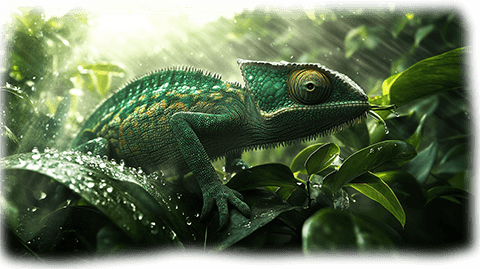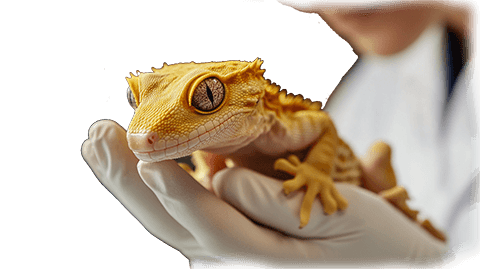Chameleon Health: Comprehensive Care for a Healthy Life
Chameleons are fascinating and delicate reptiles that require very specific care to stay healthy. From their unique ability to change colors to their specialized diet and environment, keeping a chameleon healthy can be challenging but rewarding. Understanding their health needs and recognizing signs of illness early is essential for providing the best care.
In this guide, we will cover the most common health issues that affect chameleons and offer tips on preventive care to help your chameleon live a long, healthy life.
Common Chameleon Health Issues
Chameleons can be prone to certain health issues, particularly if their environmental and dietary needs aren’t met. Some of the most common health issues are directly related to improper husbandry, so it’s essential to provide the right care from the start.

Metabolic Bone Disease (MBD)
Metabolic Bone Disease is one of the most common and preventable health problems in chameleons. It results from a calcium deficiency or an imbalance between calcium and phosphorus, often caused by insufficient UVB lighting or an improper diet.
Symptoms of MBD:
- Lethargy
- Soft, rubbery jaw or limbs
- Difficulty climbing or walking
- Swollen or misaligned bones
Prevention and Treatment
- UVB Lighting: Ensure your chameleon has access to UVB light for 10-12 hours daily. The light is crucial for vitamin D3 synthesis, which helps absorb calcium.
- Calcium Supplementation: Dust your chameleon’s food with calcium supplements at every feeding. Ensure the supplement contains vitamin D3. (Amazon affiliate link)
- Balanced Diet: Feed your chameleon a variety of insects like crickets, roaches, and worms. Gut-load the insects with high-calcium foods before offering them.
If you suspect MBD, it’s critical to consult a reptile veterinarian for proper treatment, including calcium injections and UVB adjustments.
Respiratory Infections
Chameleons are sensitive to changes in temperature and humidity, and improper levels can lead to respiratory infections. These infections can develop when the enclosure is too cold, too humid, or too dry.

Symptoms of Respiratory Infections
- Wheezing or clicking sounds
- Open-mouth breathing or excessive gaping
- Mucus around the mouth or nostrils
- Lethargy
Prevention and Treatment
- Maintain Proper Humidity Levels: Chameleons thrive in environments with 50-70% humidity (Amazon affiliate link), depending on the species. Use a hygrometer to monitor the levels in the enclosure. (Amazon affiliate link)
- Ensure Proper Temperatures: Provide a temperature gradient in the enclosure with a basking area between 85-95°F and cooler areas around 70-75°F.
- Ventilation: Make sure the enclosure is well-ventilated to prevent mold or stagnant air. Screen enclosures are ideal for chameleons as they promote airflow.
If your chameleon shows signs of a respiratory infection, consult a vet who may prescribe antibiotics or other treatments.
Dehydration
Dehydration is a common issue in captive chameleons due to their unique drinking habits. Unlike other reptiles, chameleons usually won’t drink from standing water. They need water droplets to be misted onto plants or provided by a dripper system.
Symptoms of Dehydration
- Sunken eyes
- Wrinkled or sagging skin
- Lack of feces or urates that are orange or yellow (they should be white)
Prevention and Treatment
- Misting: Mist the enclosure multiple times a day to provide water droplets on the plants and leaves. You can also use an automatic misting system.
- Dripper System: Set up a dripper system to simulate rain and provide a consistent water source. (Amazon affiliate link)
- Monitor Hydration: Check your chameleon’s urates (the white part of their waste). If they appear orange or yellow, your chameleon is dehydrated and needs more water.
In case of severe dehydration, consult your veterinarian immediately for rehydration solutions.

Mouth Rot (Stomatitis)
Mouth rot is a bacterial infection that affects a chameleon’s gums and mouth. It’s often caused by stress, poor diet, or inadequate enclosure conditions, leading to a weakened immune system.
Symptoms of Mouth Rot
- Swollen, red, or bleeding gums
- Excessive drooling or mucus around the mouth
- Discolored or foul-smelling mouth tissue
- Difficulty eating
Prevention and Treatment
- Maintain a Clean Enclosure: Regularly clean your chameleon’s enclosure to prevent bacterial buildup.
- Provide a Proper Diet: Ensure your chameleon is receiving a balanced diet to strengthen their immune system.
- Reduce Stress: Make sure your chameleon has a secure, peaceful environment with minimal handling.
If mouth rot occurs, a veterinarian will typically prescribe antibiotics and may recommend topical treatments to heal the infection.
Parasites
Internal parasites, such as worms or protozoa, and external parasites, like mites, can affect chameleons if they’re exposed to infected feeder insects or contaminated environments.
Symptoms of Parasites
- Weight loss despite a healthy appetite
- Loose stools or diarrhea
- Lethargy
- Visible mites on the skin or in the enclosure
Prevention and Treatment
- Quarantine New Animals: Always quarantine new chameleons or feeder insects before introducing them to the main enclosure.
- Regular Vet Check-ups: Have your chameleon’s fecal matter tested periodically for internal parasites.
- Proper Hygiene: Keep the enclosure clean and ensure that feeder insects are sourced from reputable providers.
A vet will prescribe antiparasitic medications if your chameleon is diagnosed with internal or external parasites.
Preventive Care Tips for Chameleon Health
To keep your chameleon healthy and prevent common issues, follow these general care tips:
- UVB Lighting: Provide UVB lighting for 10-12 hours daily to ensure proper calcium absorption. (Amazon affiliate link)
- Varied Diet: Offer a diverse range of gut-loaded insects, dusted with calcium supplements.
- Humidity Control: Maintain the right humidity level using misting systems and a hygrometer.
- Hydration: Provide consistent water through misting or dripper systems to prevent dehydration.
- Temperature Gradient: Ensure a basking area with temperatures between 85-95°F and cooler areas around 70-75°F.
- Veterinary Visits: Schedule regular check-ups with a reptile vet and address any signs of illness promptly.
Feeding Your Chameleon
Chameleons have very specific dietary requirements that contribute significantly to their overall health. A well-balanced, varied diet ensures they receive the proper nutrients, including essential vitamins and minerals.
What to Feed
- Insects: The staple of a chameleon’s diet consists of live insects such as crickets, roaches, and mealworms. For variety, you can also offer silkworms, hornworms, and black soldier fly larvae. (Amazon affiliate link)
- Gut-loading: It’s important to gut-load feeder insects by feeding them nutritious foods like leafy greens, squash, and carrots 24 hours before offering them to your chameleon.
- Supplements: Dust insects with calcium powder at every feeding, and use a multivitamin supplement 1-2 times a week. Be sure to choose a calcium supplement with or without vitamin D3 based on the UVB exposure your chameleon receives.
Feeding Frequency
- Juveniles: Young chameleons need to be fed daily as they are still growing. Offer them small, gut-loaded insects dusted with calcium.
- Adults: Adult chameleons require feeding 2-3 times per week, depending on their size and species.
Hydration During Feeding
- Water Intake: Chameleons do not drink from standing water, so misting the enclosure with a spray bottle or using a drip system during feeding encourages hydration.
Monitor your chameleon’s eating habits closely, as changes in appetite can indicate potential health problems that require veterinary attention.
When to Visit the Vet
It’s important to monitor your chameleon closely for signs of illness. Chameleons are masters at hiding their discomfort, so any changes in behavior or physical appearance should be taken seriously. Consult a vet if you notice any of the following symptoms:
- Lethargy or lack of movement
- Difficulty breathing or open-mouth breathing
- Loss of appetite or rapid weight loss
- Swollen or misaligned limbs
- Abnormal feces or urates
- Swelling around the mouth or eyes
Prompt veterinary care can prevent minor issues from becoming serious health problems.
Reading materials: “Veiled Chameleon . Veiled Chameleon Owner’s Manual. Veiled Chameleon book for care, feeding, handling, health and common myths” (Amazon affiliate link) by Jonathan Durham.
Affiliate Disclosure
This post may contain affiliate links, which means I earn from purchases made through links. Please see the privacy policy page for more details.





